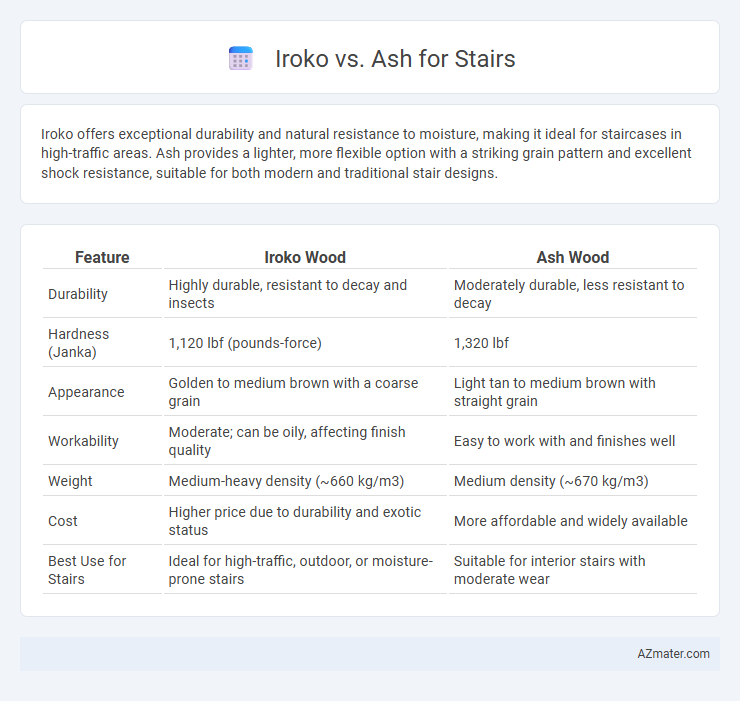Iroko offers exceptional durability and natural resistance to moisture, making it ideal for staircases in high-traffic areas. Ash provides a lighter, more flexible option with a striking grain pattern and excellent shock resistance, suitable for both modern and traditional stair designs.
Table of Comparison
| Feature | Iroko Wood | Ash Wood |
|---|---|---|
| Durability | Highly durable, resistant to decay and insects | Moderately durable, less resistant to decay |
| Hardness (Janka) | 1,120 lbf (pounds-force) | 1,320 lbf |
| Appearance | Golden to medium brown with a coarse grain | Light tan to medium brown with straight grain |
| Workability | Moderate; can be oily, affecting finish quality | Easy to work with and finishes well |
| Weight | Medium-heavy density (~660 kg/m3) | Medium density (~670 kg/m3) |
| Cost | Higher price due to durability and exotic status | More affordable and widely available |
| Best Use for Stairs | Ideal for high-traffic, outdoor, or moisture-prone stairs | Suitable for interior stairs with moderate wear |
Introduction to Iroko and Ash for Stair Construction
Iroko and Ash are prominent hardwood options widely used in stair construction due to their durability and aesthetic appeal. Iroko, known for its natural resistance to decay and rich golden-brown color, offers excellent strength and weather resistance, making it suitable for both indoor and outdoor stairs. Ash is prized for its light color, distinctive grain patterns, and superior shock resistance, providing a sturdy and visually appealing material ideal for high-traffic staircases.
Key Characteristics of Iroko Wood
Iroko wood, known as African teak, offers exceptional durability and natural resistance to decay and insects, making it ideal for staircases exposed to heavy foot traffic. Its coarse grain and golden to medium brown color deepen over time, enhancing aesthetic appeal and blending well with various interior designs. Compared to Ash, Iroko's stability and moisture resistance make it a superior choice for longevity and low maintenance in stair construction.
Distinctive Features of Ash Wood
Ash wood boasts a light color with a straight, uniform grain that enhances staircase aesthetics through natural brightness and subtle texture. Its exceptional strength-to-weight ratio contributes to durable, long-lasting stairs capable of withstanding heavy foot traffic without warping or cracking. The wood's excellent shock resistance and ease of finishing make it a preferred choice for staircases requiring both functionality and elegant design.
Durability and Longevity: Iroko vs Ash
Iroko wood offers exceptional durability and resistance to decay, making it ideal for high-traffic staircases exposed to moisture and wear. Ash wood, while known for its strength and shock resistance, tends to be less resistant to rot and insect damage compared to Iroko. For stair applications requiring long-term structural integrity and weather resilience, Iroko generally outperforms Ash in durability and longevity.
Aesthetics and Appearance Comparison
Iroko wood offers a rich, golden to medium brown hue that darkens over time, providing a warm and luxurious appearance ideal for elegant staircases. Ash features a light, creamy color with subtle grain patterns that create a bright, contemporary look well-suited for modern stair designs. The choice between Iroko and Ash ultimately impacts the staircase's visual warmth and style, with Iroko delivering a deeper, more traditional aesthetic and Ash offering a fresh, sleek appeal.
Cost and Availability: Which is More Economical?
Iroko wood tends to be more expensive than Ash due to its durability and resistance to decay, making it a premium choice for stair construction. Ash is generally more affordable and widely available, often sourced sustainably from temperate forests, contributing to lower material costs. For budget-conscious projects, Ash offers better cost-effectiveness and easier procurement compared to the pricier and less readily available Iroko.
Maintenance and Care Requirements
Iroko wood requires regular cleaning and occasional oiling to maintain its natural resistance to moisture and decay. Ash demands frequent sealing and prompt attention to scratches or dents to preserve its durability and aesthetic appeal. Both woods benefit from avoiding excessive moisture exposure to extend stair longevity and maintain surface integrity.
Installation Considerations for Each Wood
Iroko wood offers excellent durability and natural resistance to moisture, making it ideal for staircases in both interior and exterior settings; however, it requires proper pre-drilling due to its hardness to prevent splitting during installation. Ash is lighter and easier to work with, allowing straightforward cutting and fastening, yet it demands thorough sealing and finishing to protect against wear and potential moisture damage. Both woods benefit from professional installation techniques tailored to their grain patterns and density to ensure secure, long-lasting stairs.
Environmental Impact and Sustainability
Ash wood is a renewable resource that grows relatively quickly, making it a more sustainable choice compared to Iroko, which is a slower-growing tropical hardwood often sourced from West African forests. Iroko's harvesting can contribute to deforestation and biodiversity loss, while Ash plantations generally support better forest management and carbon sequestration. Choosing Ash for stairs reduces ecological footprint due to its higher availability and lower environmental impact compared to the more ecologically sensitive Iroko.
Choosing the Right Wood for Your Stairs: Iroko or Ash?
Iroko offers exceptional durability and natural resistance to moisture and insects, making it ideal for high-traffic staircases in both indoor and outdoor settings. Ash wood provides a lighter color and excellent shock resistance, delivering a classic aesthetic and a slightly softer feel underfoot, suitable for interior stairs that balance strength and elegance. When choosing between Iroko and Ash for stairs, consider Iroko's robustness and weather resistance against Ash's flexibility and bright appearance to match your specific design and functional needs.

Infographic: Iroko vs Ash for Stair
 azmater.com
azmater.com